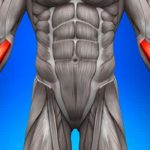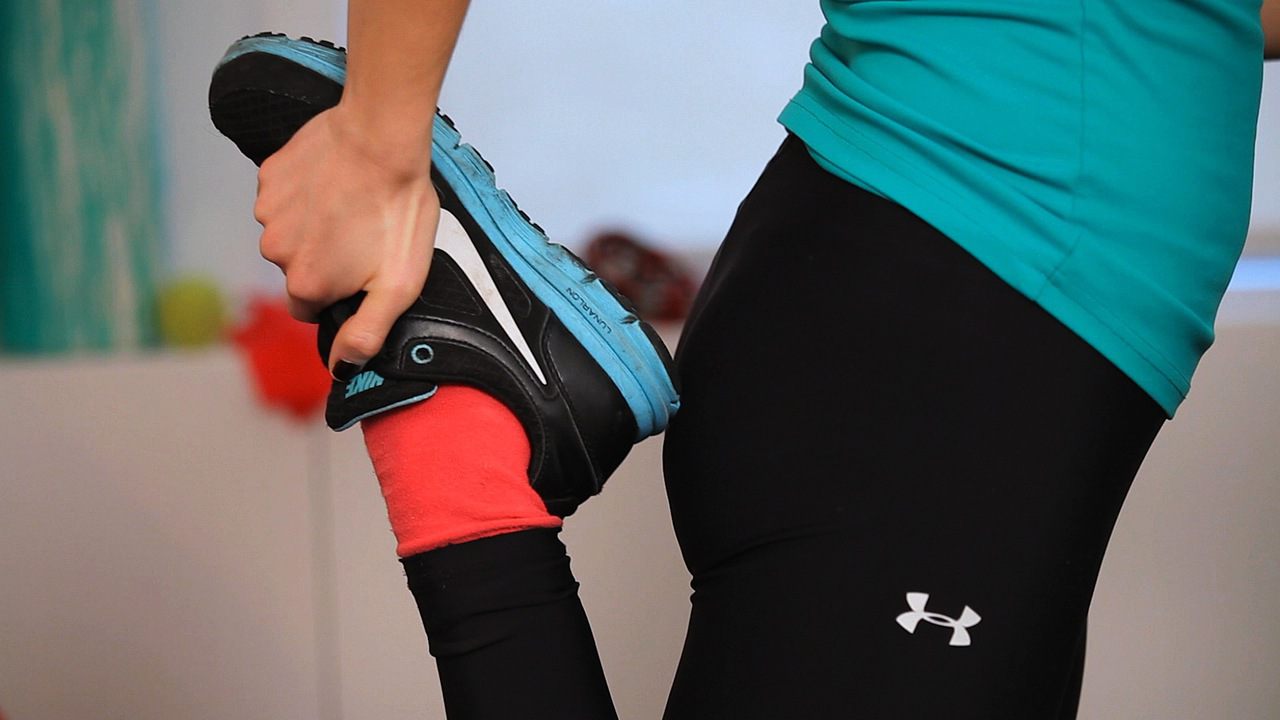
At the very beginning of the article, we want to warn that there are many causes of pain in the knee joints and knee exercises to prevent pain. Correct diagnosis of your case can only be made by a specialized specialist (traumatologist, rheumatologist, orthopedist or physiotherapist). It is extremely important to get professional advice, because the exercises described in this article, in certain cases (such as arthrosis of knee joints) are not only unacceptable in combating pain in the knee joint, but can further exacerbate the unfavorable situation.
Content of the article:
- How to get rid of pain in the knee joint?
- Exercises from pain in the knees:
- Stretching the calf against the wall
- Squeeze the calf with a tennis ball
- Stretching the hip, knee and quadriceps
- Extension of the quadriceps by means of a foam roller
- Stretching of the knee tendon
- Rises of a straight leg
- Conclusion
However, most often the pain in the knee occurs either from direct injuries (stroke, fall, etc.), or due to overload in the process of active sports (running, cycling, training in simulators, jumping, etc.) or household chores.
By and large, pain in the knees is a fairly common complaint. After all, knee joints are experiencing huge loads every day, which makes them vulnerable and easily injured.
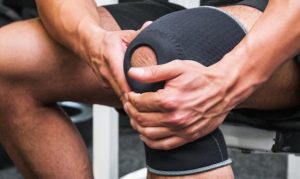
Without seriously digging into the anatomy of the human body, we note that the knee joint is the largest and most complex in its structure in the entire human body. It is located at the junction of the femur and bones of the lower leg. The thigh to the knee is attached with the help of muscles, tendons and ligaments. Menisci are the peculiar shock absorbers in the knee. The knee cap also protects the articular cartilage from impacts. Already the very structure of the knee joint gives an understanding that the cause of pain can be in damage to any of its constituent tissues: the knee cartilage, ligaments, tendons, periarticular bags, etc.
In addition to pain, the symptoms of problems with the knee may be a decrease in its mobility, swelling, an increase in body temperature in the affected area. All these signs may indicate the development of arthritis, i.e. inflammation of the musculoskeletal system. In this case, therapeutic forearm exercises really help to create a miracle, saving you from pain in your knees.
How to get rid of pain in the knee joint?
So, how do you know if you are at risk? Factors such as lack of activity, overweight, poor posture, improper treatment of injuries and meager nutrition can contribute to the pain in the knees, Ripp says. Fortunately, taking care of your knees throughout your life, starting at the age of thirty, will help strengthen joints and will save you from many years of daily pain and discomfort. Try to perform uncomplicated gymnastics for the knee joints.
Exercises from pain in the knees
Stretching the calf against the wall
Muscles of calves are often neglected during stretching. However, those who are engaged in jogging, intensive training or spend a lot of time on their legs, stretching calves are just necessary, according to Williams. Caviar can be too strained from the loads, they need to be stretched to relieve any pain that can then migrate to the knee.
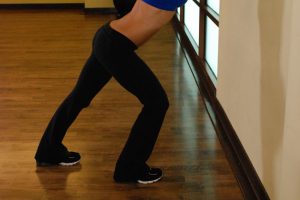
Select the wall on which you can lean. Stand facing the wall, bend the right foot and position the heel at the junction of the floor and the wall. The toes should be on top, and the heel should remain on the floor. Keeping the heel on the floor, and the foot as straight as possible, lean forward, stretching the leg at its deepest point. Hold in this position for five seconds before relaxing, working for a deeper stretching. Repeat the stretching for the left foot. Try to do 10-15 repetitions for each leg, or even more if you still feel the tension.
Squeeze the calf with a tennis ball
Williams argues that this exercise with pain in the knees will help you relieve tension in both the calf and the hamstring. Sit on the floor and pull up the right foot to the buttocks, the knee is bent. Place the tennis ball (or yoga, or massage ball) under the right knee, clutching it between the caviar and the knee tendon. Create a “pressure” by pulling the shin toward you, then rotate your foot in a circular motion to create space in the knee joint. Continue until you feel that the tension in this area has subsided, change your leg.
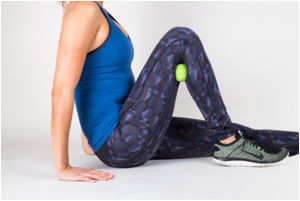
Stretching the hip, knee and quadriceps
This stretching is not only pleasant in sensations, but also brings a double benefit to the muscles of your thighs and quadriceps.
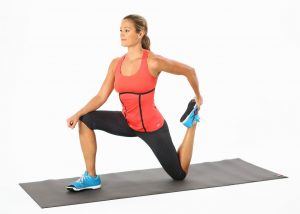
Stand on one knee (you can put a towel or rug), the second leg is exactly in front of you. Make a 90 degree angle between the legs. Lean forward to the front leg, stretching the front of the thigh down. Then, grasp the ankle of the leg that is on the floor and pull it to the buttocks to get a deep stretch of the knee and the thigh. This will have a beneficial effect on your knee exercises. Repeat this exercise 10-15 times, or more, depending on the voltage level.
Extension of the quadriceps by means of a foam roller
Stretching quadriceps is vital, as they become from the sedentary lifestyle that most of us lead, and often are in tension. To again force this large group of muscles to function as best as possible, Williams suggests using a foam roller.
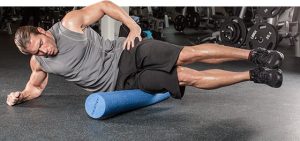
Lie on your stomach, put a foam roller on your right foot, right under your quadriceps. Most of the mass of your body is spread over your leg, slowly roll over. Instead of just rolling forward backwards, swing your leg from side to side, concentrating pressure on the most tense parts of your muscles. Change your legs. Continue rolling until the pain goes away. If this is not possible (like some runners!), Perform at least five minutes.
5. Stretching of the knee tendon
Our knee tendons affect the knees more than we think, and can become a source of discomfort or pain.
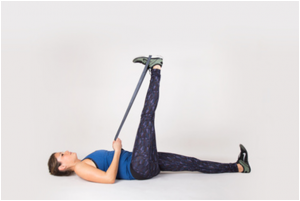
Lie on your back, your left foot on the floor, your feet are tense. Take the right leg and rest it on a wall or table, or use an elastic band. This stretching should stretch the lower back of the leg, starting from the knee exercises. As soon as you feel the deepest point of the stretching, alternate for 5 seconds, relax and strain the foot of the right foot. If you have increased flexibility, hold the ankle of your right foot and pull it toward you. Try to perform 10-15 times with a delay of 5 seconds, continue if you still feel the tension. Repeat for the left foot.
6. Rises of a straight leg
Simple stretching exercises, such as lifting the legs, help prevent knee stretch, and also activate and strengthen the quadriceps.
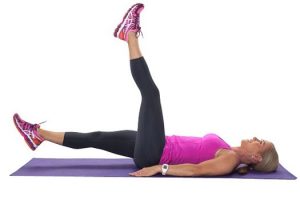
Lie on your back, one knee is bent, and the other foot is on the floor in front of you. Raise a straight leg approximately 30 cm from the floor, rotating it from yourself (the entire leg rotates, so that the fingers point to you, instead of the ceiling). Make 3 sets of 10-15 repetitions, changing legs. When you become stronger, weight the foot in the ankle by 5 kg.
Conclusion
Pain in the knee joint is a problem of modern civilization: for example, in Europe and Germany, every second person encounters these unpleasant symptoms. Distinguish different forms of pain in the knee. To determine the causes of pain in the knee in each specific case is possible only on the basis of careful medical examination.
Pain in the knee, accompanied by swelling, swelling, fluid congestion and soft tissue changes, can be particularly well studied using ultrasound diagnostics.
In a different group of people, pain in the knee joint can occur for various reasons:
- For example, bicycles have patella pain (pain of the kneecap) due to overstrain of the knee joint
- Footballers cause knee pain is the defeat of the meniscus
- The cause of pain in the knee, often accompanied with pain in the spine, is the programmers stay in a sitting position for a long period of time, as a result of which deformation of the cartilaginous tissue occurs.





